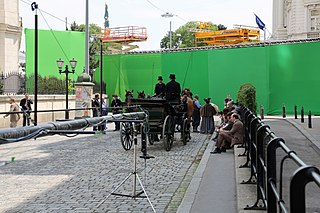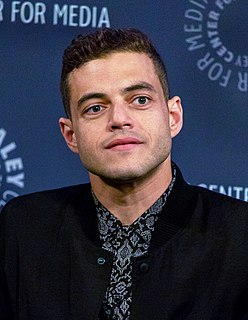The Academy Award for Best Makeup and Hairstyling is the Academy Award given to the best achievement in makeup and hairstyling for film. Usually, only three films are nominated each year rather than five as in most categories. The exception is in the early 1980s as well as 2002, when there were only two nominees; and in 1999, when there were four nominees.
The Academy Award for Best Sound Editing is an Academy Award granted yearly to a film exhibiting the finest or most aesthetic sound design or sound editing. Sound editing is the creation of sound effects. The award is usually received by the Supervising Sound Editors of the film, sometimes accompanied by the Sound Designers.

Portrait of Jennie is a 1948 fantasy film based on the novella by Robert Nathan. The film was directed by William Dieterle and produced by David O. Selznick. It stars Jennifer Jones and Joseph Cotten. At the 21st Academy Awards, it won an Academy Award for Best Special Effects. Joseph H. August was also nominated for an Academy Award for Best Cinematography - Black and White.
Gordon Jennings, A.S.C. was an American special effects artist. He received seven Academy Awards and was nominated for eight more in the same category. After starting 1919 in Hollywood as camera assistant he worked from 1932 until 1953 on the visual and special effects of more than 180 films. His older brother was cinematographer Devereaux Jennings (1884-1952), who filmed, for instance, Buster Keaton's monumental The General in 1926.
Nick Allder is an English special effects supervisor and coordinator. He started his career as an assistant camera operator and moved, after eight years, into special effects. He has won multiple awards, including an Academy Award for Best Visual Effects for the science-fiction horror film Alien (1979), and a BAFTA Award for Best Special Visual Effects for the science-fiction film The Fifth Element (1997). Allder has worked on the set of high-grossing films such as the epic space opera The Empire Strikes Back (1980) and the historical drama film Braveheart (1995).
Nathan Levinson was an American sound engineer. He won an Oscar in the category Sound Recording for the film Yankee Doodle Dandy and was nominated for 16 more in the same category. He was also nominated seven times in the category Best Special Effects.
Jack Whitney was an American sound engineer. He won two Academy Awards, one for Best Sound Recording and the other for Best Visual Effects. He was nominated six more times in the category Best Sound.
Carlton W. Faulkner was an American sound engineer. He won an Oscar in the category Sound Recording for the film The King and I. He was also nominated for four more Academy Awards, three in the same category and the fourth for Best Effects, Special Effects.
Roger Heman was an American sound engineer. He won an Academy Award for Best Sound and was nominated for another one in the same category. His father was also a sound engineer and also won an Academy Award, for Best Effects, Special Effects for Crash Dive.
John Richardson is a British special effects supervisor. He is best known for his work on the James Bond film series, all the Harry Potter film series (2001-2011), A Bridge Too Far (1977) and Aliens (1986). For the latter, he won the Academy Award for Best Visual Effects at the 1987 ceremony. He won the BAFTA Award for Best Special Visual Effects for his work on the film Harry Potter and the Deathly Hallows – Part 2 (2011), for which he was also nominated for an Academy Award at the 2012 ceremony.
Lawrence W. Butler was an American special effects artist, best known as the inventor of the bluescreening process. He won an Academy Award for Best Special Effects and was nominated for three more in the same category.

Paul Eagler was an American special effects artist. He won an Academy Award for Best Special Effects and was nominated for another one in the same category.
Louis Mesenkop was an American sound engineer. He won two Academy Awards for Best Special Effects and was nominated for another in the same category. Mesenkop was part of the production team who received an Academy Honorary Award at the 11th Academy Awards for their efforts on the Paramount film Spawn of the North.
Warren Newcombe was an American special effects artist. He won two Academy Awards for Best Special Effects and was nominated for another one in the same category. He worked on more than 200 films during his career.
Dave Shirk is a visual effects supervisor. Shirk and his fellow visual effects artists are won the Academy Award for Best Visual Effects for the 2013 film Gravity. He has been nominated for the Academy Award for Best Special Effects for Ready Player One.
Russell Shearman was an American special effects artist. He won a Technical Achievement Award at the 19th Academy Awards in 1946 along with the RKO Radio Studio Special Effects Dept. for the development of a new method of simulating falling snow on motion picture sets for It's a Wonderful Life. It's a Wonderful Life won just the one Academy Award, in the Technical Achievement category for developing a new method of creating artificial snow. Before It's a Wonderful Life, fake movie snow was mostly made from cornflakes painted white and it was so loud when stepped on that any snow-filled scenes with dialogue had to be re-dubbed afterwards. RKO studio's head of special effects, Russell Sherman, developed a new compound, utilizing water, soap flakes, foamite and sugar. He won an Academy Award during the 21st Academy Awards for Best Special Effects. He won for the film Portrait of Jennie. He shared his win with Paul Eagler, Charles L. Freeman, Joseph McMillan Johnson, Clarence Slifer and James G. Stewart.
A. D. Flowers was an American special effects artist who was perhaps best known for his work on Tora! Tora! Tora!. For which he won an Academy Award. He also "created memorable scenes" for the films "The Godfather" and "Apocalypse Now".
Charles L. Freeman was an American sound editor and film editor who worked on both television and film.



